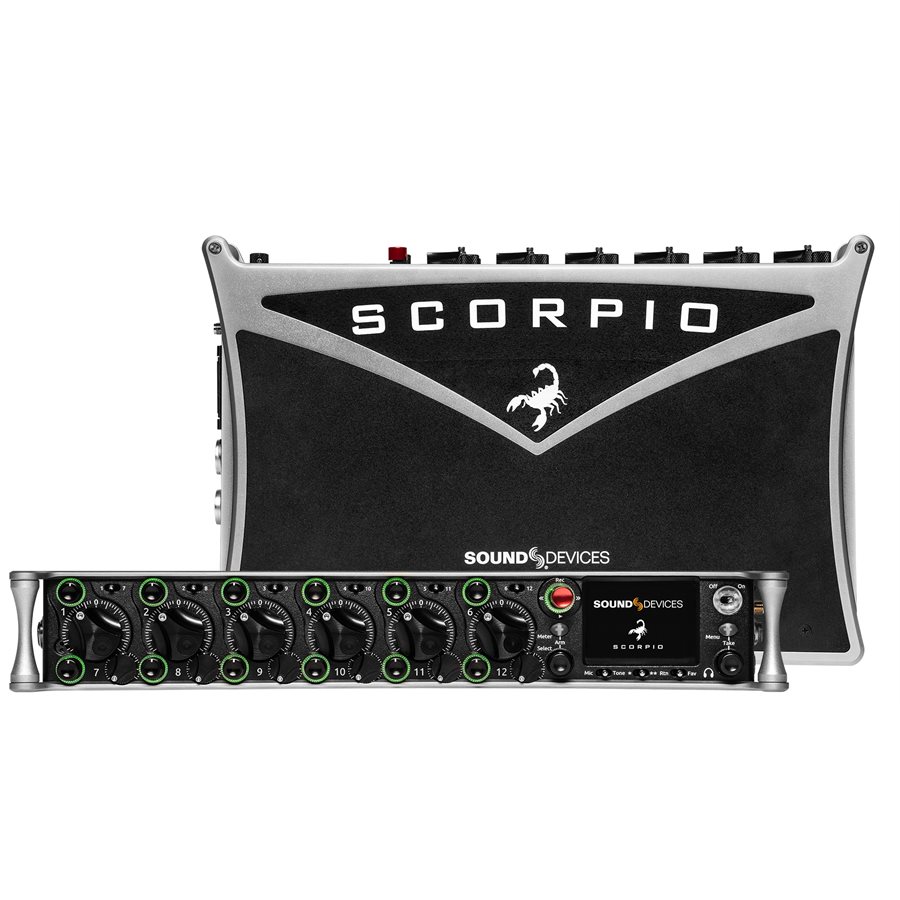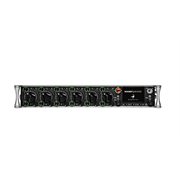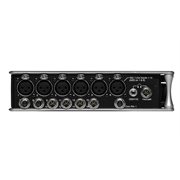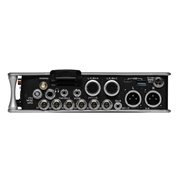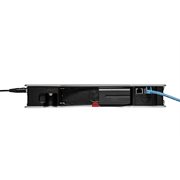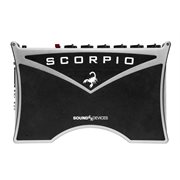- 1800 717 710 | Newsletter |
- FAQ |
- Contact
-
0 product
My Cart - Quick Order
- Home>
- Audio>
- Mixers/Recorders>
- Mixers & accessories>
- Mixers with integrated recorders>
- Sound Devices Scorpio Mixer Recorder with 16 mic / line preamps, 32 ch of Dante in & out
Sound Devices Scorpio Mixer Recorder with 16 mic / line preamps, 32 ch of Dante in & out
Product code : SOU.SCORPIO
Scorpio is a 32 channel, 36 track mixer-recorder and the most powerful product ever designed by Sound Devices. With 16 mic/line preamplifiers, 32 channels of Dante in and out, AES in and out, 12 analog outputs and multiple headphone outputs, Scorpio is well-suited for any production scenario. A fully-customizable routing matrix enables sound professionals to send any input to any channel, bus, or output. Up to 12 buses may be individually mixed. Due to its compact form factor, the Scorpio is equally at home over-the-shoulder or in a mobile rig.
Since its release in April 2019, Scorpio has received the 56th CAS Outstanding Product in Production Award, the 2020 AMPS Excellence in a Production Audio Project Technical Award, PSNEurope Best of Show Award at IBC2019, Editor’s Choice 2019 Award from Professional Audio, and Resolution Magazine Award for Best Recorder, 2019.
Scorpio incorporates Sound Devices’ most cutting-edge technology. An ultra-powerful engine comprised of three FPGA circuits and six ARM processors deliver the horsepower needed for the most complex tasks. FPGA-based audio processing with 64-bit data paths ensures the highest sound quality and reliability. The Scorpio also features Sound Devices’ latest and best in analog microphone preamplifier design. These preamps have the smoothest sound and lowest noise of any preamp in the company’s 20-year history and include built-in analog limiters, high pass filters, delay, 3-band EQ and phantom power.
The Scorpio has an internal 256GB SSD and can simultaneously record to two SD cards for redundancy. For additional flexibility, sound professionals can send different files to their choice of media.
Great attention to detail has been paid to every aspect of the Scorpio’s design. Most common menus are accessible with only one or two button presses, and many menu shortcuts can be achieved with only one hand. Scorpio features a built-in dual L-Mount battery charger and may be powered with L-Mount batteries or via the TA4 DC inputs using smart batteries, NP-1 batteries, or in-line power supplies. The ultra-accurate, fully-featured timecode generator contains its own battery to hold timecode for up to four hours after power off.
Enable Dugan Automixing or MixAssist to automatically attenuate unused microphones in multi-microphone applications. Up to 16 channels can be automixed at a time, and two separate groups can be mixed simultaneously. Scorpio’s intuitive LED metering and sunlight-readable screen display accurate Dugan channel attenuation and gain distribution across all channels. If you are recording in a noisy environment, enable the optional NoiseAssist or CEDAR sdnx plugins to suppress common background noises instantly on-location.
Get the perfect fit on your cart with the Sound Devices CL-16 or one of several supported USB control surfaces for remote fader and transport control. Download the companion Android and iPad app, SD-Remote, to access to transport controls, metering, and sound reports on a large touch screen. The SL-2 Dual SuperSlot Wireless Module easily mounts to the top panel, providing up to four channels of wireless audio in each slot.
Elevate your kit with the Scorpio Premium Portable Mixer-Recorder.
32 channels, 12 buses, 36 tracks
32 channels of Dante I/O
256 GB internal SSD, 2 SD card slots
USB-A and C ports for SD-Remote app, linear fader control via MCU, keyboard, and file transfer
Dugan Automixing/MixAssist for up to 16 channels
Optional NoiseAssist and CEDAR sdnx noise suppression plugins
Analog Inputs
-
Frequency Response
- 10 Hz to 80 kHz ± 0.5 dB (192 kHz sample rate, re 1 kHz)
-
THD + Noise
- 0.005% max (mic in, 1 kHz, 22 Hz–22 kHz BW, trim at 20, fader at 0, -10 dBu in)
-
Equivalent Input Noise
- -131 dBV (-129 dBu) max (mic in, A-weighting, 76 dB gain, 150 ohm source impedance)
Processing Engine
- Highly extensible, full FPGA-based audio processing, 3 FPGAs
- Six-way ARM multiprocessor system
- 64-bit audio processing precision
Audio Over Ethernet
- Dante, AES67 compatible
- 2 channels in, 32 channels out (up to 96 kHz); 16 channels in, 16 channels out (192 kHz)
- 1 Gb/s Ethernet, 2 ports, transformer-balanced
Inputs
-
Mic/Line inputs
- 16 total, all fully featured; 6 on full-size XLR, 2 on TA3, 8 on TA5
-
Inputs
- Mic-level inputs: (XLR, TA3, TA5): Class-A, discrete differential long-tail pair, 4k ohm input impedance
- Line-level inputs: (XLR, TA3, TA5): active-balanced, 4k ohm input impedance
- 48V phantom: full 10mA to all 16 inputs simultaneously
- AES3 or AES42 available on XLR inputs 1 and 6
- AES42: +10 V, 250 mA available, mode-1, auto-ASRC
- Rtn A, B, C (3.5 mm/10-pin): unbalanced 2-channel, 4k ohm input impedance
- Com Rtn 1,2 (TA3, 3.5mm) balanced, 1-channel, 8k ohm input impedance
- External Slate Mic (TA5): balanced, 8k ohm input impedance, menu-selectable 12 V phantom
-
Maximum Input Level
- Mic: +8 dBu (2.0 Vrms)
- Line: +28 dBu (19.5 Vrms)
- Rtn A, B, C: +18 dBu (6.2 Vrms)
- Com Rtn 1, 2: +24 dBu (12.3 Vrms)
- External Slate Mic: +12 dBu (3.2 Vrms)
High-Pass Filters
- Adjustable 10 Hz to 320 Hz, 18 dB/oct. 1st stage analog (before preamp), 2nd stage digital.
Limiters
- Limiters available at all channels, buses and headphones for all sample rates
- Analog first stage, all subsequent stages digital
- Attack time: 1 ms
- Release time: adjustable, 50 ms to 1000 ms
- Threshold: adjustable, -2 dBFS to -12 dBFS
- Selectable ratio: inf:1, 20:1
Delay
- Channel Adjustable 0-50 ms
- Output Adjustable 0-500 ms
Maximum Gain
- Trim stage (mic input): 76 dB
- Trim stage (line input): 50 dB
- Fader stage: 16 dB
- Bus stage: 16 dB
- Headphone stage: 20 dB
- Mic-to-Line: 108 dB
- Mic-to-Headphone: 112 dB
Outputs
-
Outputs
- XLR (L, R) active-balanced, 250/3.2k/120 ohms (mic/-10/line)
- Hirose 10-pin (L, R) active-balanced, 250/3.2k/120 ohms (mic/-10/line)
- TA3 (X1-X6) active-balanced, 250/3.2k/120 ohms (mic/-10/line)
- 3.5mm (X7, X8): unbalanced, stereo, 1.8k ohms
-
Headphone Outputs
- ¼”, 3.5 mm
- TA5 (along with mic input pins) for single connection to headset + mic
- High output, 4 ohm output impedance, 400 mW + 400 mW at each connector, all individually driven
- Compatible with headphones of any impedance
-
Maximum Output Level (all into 10k load)
- Line: +20 dBu (7.8 Vrms)
- “-10”: +6 dBu (1.5 Vrms)
- Mic: -20 dBu (0.078 Vrms)
- X7/X8 Out: +6 dBu (1.5 Vrms)
- Headphone outputs (¼”, TA-5, X9/X10): +14 dBu (4.0 Vrms)
-
Digital Outputs
- AES3 transformer-balanced, in pairs; 1-2 (XLR-L), 3-4 (XLR-R), 5-8 (Hirose 10-pin A)
- 110 ohm, 2 V p-p, AES and S/PDIF compatible
Recording
-
A/D Converters
- 32-bit, 120 dB, A-weighted dynamic range typical
- Sampling rates 44.1 kHz, 47.952 kHz, 48 kHz, 48.048 kHz, 88.2 kHz, 96 kHz, 192 kHz
-
Recording
- Internal 256 GB SSD; two removable SD Cards. Each 10% over-provisioned (reserved free space) for optimum performance
- Simultaneous recording to internal SSD and the two SD cards
- exFAT formatting
- 36 tracks (32 iso channels, 4 buses)
- Broadcast WAV monophonic (48048 and lower) and polyphonic file format
- 64-bit WAV (RF64) monophonic and polyphonic; support for files > 4 GB
USB
- USB-C (USB 3.1 type 1) for file transfer of internal SSD, both SD Cards
- USB-A host for keyboard, external controller, external USB hubs supported for connecting multiple devices
Timecode and Sync
- Modes Supported: Off, Rec Run, Free Run, 24h Run, External, including External Auto-Record and Continuous modes.
- Frame Rates: 23.98, 24, 25, 29.97 DF, 29.97 ND, 30 DF, 30 ND
- Sample/Timecode Accuracy: 0.1 ppm (0.25 frames per 24 hours)
- Timecode Input: 20k ohm impedance, 0.3 V - 3.0 V p-p (–17 dBu - +3 dBu)
- Timecode Output: 75 ohm impedance, 5 V p-p (+12 dBu)
- Word Clock Input: 10k/75 ohm selectable impedance, 1-5 V p-p input sensitivity
- Word Clock Output: 75 ohm impedance, 5 V p-p output, at SR
Remote Control
- USB MIDI MCU Control - supported 3rd party fader controllers
- SD-Remote Android app
- USB Keyboard
- External Timecode Record Trigger
LCD
- 320x240, Transflective, excellent sunlight visibility
- Larger touchscreen display available via USB-connected SD-Remote app
Power
- External: dual 10-18 V inputs on locking TA4 connectors, pin-4 = (+), pin-1 = (-)
- Dual rear-mount Sony-style L-mount batteries with chargers
- Idle Current Draw: 875 mA @ 12 V (10.5 W)
- Intelligent power-down of unused mic preamps and other internal circuits
Environmental
- Operating: -20° C to 60° C, 0 to 90% relative humidity (non-condensing)
- Storage: -40° C to 85° C
Dimensions (H x W x D)
- 5.1 cm x 32 cm x 20.5 cm
- 2.0 in. x 12.6 in. x 8.1 in
Weight
- 5.8 lbs (unpackaged, without batteries)
- 2.63 kg (unpackaged, without batteries)
What’s with the name?
Scorpio is the most powerful mixer-recorder we’ve ever created, so we wanted to give it an instantly memorable name. Scorpio is also the 8th sign in the zodiac – perfect for the 8-Series line of mixer-recorders.
The 833 is similar to the tried and true 633 but with substantially more powerful hardware.
The 888 replaces and improves upon the popular 688 and 788T.
How big is it?
Refer to the Specs tab of this product page
The Scorpio is roughly the size of the 688.
The 833 is roughly the size of the 633. The 833 has more depth but is slimmer than the 633.
The 888 is roughly the size of the 788T – just a bit thicker.
What production bags fit my mixer-recorder?
K-Tek, PortaBrace, Orca, and others all make bags for the 8-Series. The perfect bag for you depends on your set-up. Please contact bag manufacturers for suggested models!
Is the 8-Series difficult to operate?
No – the tactile interface makes it perfect for run-and-gun productions. For users familiar with Sound Devices’ 6-Series, the 8-Series will feel very similar. The menus and physical controls are very much alike. However, due to the much greater capability, there will be some learning curve. Plan to take a couple of hours to familiarize yourself with your 8-Series mixer-recorder before using it in mission critical applications.
What does the antenna connection do?
The antenna is used to connect the 8-Series via Bluetooth LE to SD-Remote, the companion app for Android, iPhone, and iPad.
I lost or broke my antenna, is there a replacement part available?
Yes. You can purchase the XL-ANT2.4 Replacement Antenna for 8-Series from your preferred reseller
I work outdoors, how does the LCD perform in sunlight?
We carefully selected the LCD based on size and performance – both indoors and out. The transflective LCD is clearly visible in direct sunlight.
I noticed my 8-Series mixer-recorder can get warm when in use, is this normal?
Yes. By design, the chassis gets warm, wicking away the heat from the internal components. The cooling of internal components is important for long-term reliability; this is accomplished via our electro-mechanical design which uses high-thermal-conductivity aluminum and direct heat-sinking of critical internal components.
The 8-Series’ quiet mic preamps and powerful processing engines are state-of-the-art, and this level of mixing/recording power in a compact chassis leads to a bit of heat being generated.
Best practices for keeping your mixer-recorder as cool as possible include powering down unused channels when not in use, leaving at least ½” of air space around it when used within a bag, and by opening rear/side flaps of the bag to allow air to flow.
Powering
What are my options for powering my 8-Series mixer-recorder?
Scorpio can be powered from several sources, including two DC inputs (TA4 connectors) or two L-Mount batteries. If the SL-6 is in use, the SL-6 4-pin Hirose DC input or NP-1 battery powers the entire system.
The 888 and 833 can be powered via the DC input on a TA4 connector or two L-Mount batteries.
All power sources operate in series, allowing for long run times.
Can my 8-Series mixer-recorder charge the L-Mount batteries?
Yes. There are two built-in chargers, one for each battery. These can be turned off via the menu.
Why did you choose to use the TA4 for power instead of the 4-pin Hirose on other SD products?
All 8-Series mixer-recorders can draw a significant amount of peak current: the battery chargers can draw over 3 A alone, and 4-pin Hirose connectors are only rated for 2 A per pin. The TA4 connector provides up to 5 A per pin and allows the use of smart batteries.
How should I wire the TA4 to connect to a standard battery?
For standard, only use pins 1 and 4 for connection.
What smart batteries can I use?
You can use smart batteries from AudioRoot, Inspired Energy, etc. We have our own labeled smart battery called the XL-SmartBattery.
Can I use Hawk-Woods data batteries like the NP-98D?
Yes. The Hawk-Woods NP-98D data batteries communicate battery telemetry to the 8-Series when connected via the Hawk-Woods NPD-TA4 shoe.
Please note that the current Sound Devices XL-NPTA4 does not support data communications.
https://www.hawkwoods.co.uk/Sound/P/NP-98D
https://www.hawkwoods.co.uk/Sound/P/NPD-TA4
What battery information can be read/displayed from smart/data batteries?
When a smart or data battery is in use, the battery’s time remaining and percent remaining are displayed on the meter screens. In the Power menu, you can also view the battery’s cycle count and temperature.
Can I use a smart/data battery to power the SL-6 with Scorpio?
You can power the SL-6 with Scorpio using a smart or data battery but no battery telemetry will be displayed on the Scorpio interface. The SL-6 hardware does not support the data lines needed to read this information.
Inputs/Outputs
How is routing different from the 688 or 788T?
Unlike the 688 and 788T, all 8-Series mixer-recorders have a full I/O matrix and multiple mix buses. Each physical input can be routed to any combination of buses, tracks, and outputs.
Can I send channels at different levels to multiple buses?
Yes. All channels feed the Left and Right mix bus post-fader. Additional buses can be fed from any channel, pre-fade or post-fade, or with a unique bus send level.
What are my options for each channel?
On Scorpio, channels 1-32 can be fed from analog mic or line, AES3 or AES42 (XLR inputs 1 and 6), USB 1 or 2, Dante, optional SL-2 accessory, optional SL-6 accessory, optional XL-AES accessory, or Rtn-A, -B, or -C. Channels 1-16 are fully featured with trim, delay, polarity, high-pass filters, 3-band EQ, pre-and post-fade compressors, stereo or MS linking, and pre- and post-fade limiting. Channels 17-32 include trim, high-pass filters, pre-and post-fade compressors, and limiters.
On the 888, channels 1-16 can be fed from analog mic or line, AES3 or AES42 (XLR input 1), USB 1 or 2, Dante, optional SL-2 accessory, optional XL-AES accessory, or Rtn-A or -B. All channels are fully featured with trim, delay, polarity, high-pass filters, 3-band EQ, pre-and post-fade compressors, stereo or MS linking, and pre- and post-fade limiting.
On the 833, 8 channels can be fed from any of the six analog mic or line inputs, AES3 or AES42 (XLR inputs 1), USB 1 or 2, optional SL-2 accessory, optional XL-AES accessory, or the Return (Rtn). All channels are fully featured with trim, delay, polarity, high-pass filters, 3-band EQ, pre-and post-fade compressors, stereo or MS linking, and pre- and post-fade limiting.
How do I control channels that don’t have front panel access?
Each channel has an associated Channel screen from which you can setup any channel parameter. Trims, faders and bus sends for Channels 13-32 (Scorpio), channels 9-16 (888) and channels 7-8 (833) are controlled through their channel screens which may be accessed via the Menu or by using the star toggle switches + PFL toggle. For physical fader and trim control of these additional channels, a supported USB control surface may also be used.
Do all microphone preamplifiers support 48 V phantom power?
Yes, and phantom provides a full 10 mA per channel.
Can I adjust the levels of incoming Dante audio?
Yes. On the Scorpio and 888, Dante audio routed to channels can be controlled with trim (pre-fade gain) and faders.
Can I use my 833, 888, or Scorpio as an audio interface to my computer?
Yes, the 833, 888, and Scorpio all support two channels in and out over USB-C. The mixer-recorder will show up as a USB audio device using the computer’s class compliant drivers. Mac supports up to 24-bit, 192 kHz, and Windows 10 supports up to 24-bit, 96 kHz.
Additionally, via Dante, the 888 acts as a 16 channel in and out audio interface, and the Scorpio acts as a 32 channel in and out audio interface.
Can I link multiple 888s or Scorpios together?
Yes, two 888s or Scorpios can be linked via audio through Dante. On Scorpio, all 32 ISO tracks, plus 4 buses, can be recorded on the second Scorpio to three storage media simultaneously. On the 888, send up to 16 channels of Dante to another 888 or a Scorpio. All recorded tracks then appear on one unit and one set of media.
How do I properly wire the TA5 Headset?
When wiring up a headset with the TA5 connector, it is important that the balance microphone signals are wired to shielded twisted pair *separate from the headphone signals*. Keep in mind that there can be >80 dB of amplification between the mic and the headset and just a bit of bleed between the mic signal and headphone signal can lead to oscillation.
You can also buy a premade headset, such as these options from Remote Audio.
My setup requires more AES inputs, how can I use more AES sources?
Check out the optional accessory XL-AES: 8 Channel AES3 Input Expander for 8-Series for connecting AES3 sources. If you are looking to send AES audio from wireless slot-in receivers, you can simplify your setup using the SL-2 Dual SuperSlot Wireless Module.
Does the XL-AES come with an extension cable? Will you offer one?
The XL-AES is designed to connect directly to the top panel expansion port of any 8-Series mixer-recorder. An extension cable is not available or supported.
Does the XL-AES rotate or can it be positioned another way than with the connectors facing the rear of the 8-Series mixer-recorder?
The XL-AES needs to be connected and mounted with the TA3 connectors facing the rear of the unit.
Does the XL-AES add 8 extra channels and tracks to the 833, 888, or Scorpio?
The XL-AES provides additional AES3 inputs to feed the existing channels and tracks of the mixer-recorder. If you need extra channels you should consider the 888 or Scorpio.
When the XL-AES is attached, where can I put my receivers?
The XL-AES was designed to have a very small footprint. The overall height of the 8-Series Mixer-Recorder only increases by .75-inches (19 mm) when the XL-AES is attached leaving plenty of room in the bag for other devices.
Are the XL-AES inputs sample rate converted?
Yes all eight channels of the XL-AES are sample rate converted to the 8-Series clock source. This alleviates any concern of clocking issues with multiple digital input sources.
What is the +4 Plugin for the 833?
The +4 plugin adds four fully-featured ISO channels/record tracks, turning your 833 into a 12 channel, 16 track mixer-recorder. These additional channels can be sourced from any input and routed to the main mix bus, additional buses, and any output. The +4 plugin requires 8-Series and SD-Remote v8.80 or higher to run.
Recording
How many tracks can I record at the various sampling rates?
Scorpio – 36 tracks at sample rates 96 kHz and below, and up to 18 tracks at 192 kHz.
888 – 20 tracks at sample rates 96 kHz and below, and up to 18 tracks at 192 kHz.
833 – All 12 tracks can be recorded at 192 kHz. With the optional +4 Plugin, all 16 tracks can be recorded at 192 kHz.
Can I arm or disarm tracks during recording?
Yes. When a track is armed or disarmed during recording, a new file is created, including the added track, or excluding the disarmed track, respectively. The two files will be sample-continuous. This feature is great for reality show productions or any production where recording never stops.
It appears that most recorders have a maximum file size of 4 GB? What if I want to record long events without the files splitting at 4 GB?
The 8-Series supports the exFAT file system and RF64 WAV (64-bit) files. This allows file sizes up to 16 EB (ExaBytes – 260). In other words, you can fill up the entire 256 GB internal SSD with a single file with no splits.
Can the 8-Series record compressed audio files like MP3, AAC, etc, for transcription purposes?
The Scorpio, 888, and 833 allow real-time recording of a two-track, timecode-stamped AAC file from LR or B1B2.
Why AAC and not MP3?
AAC and MP3 are both lossy digital compression audio formats. AAC (Advanced Audio Coding) files achieve better sound quality than MP3 at a given file size.
I see 32-bit A/D Converters listed in the specs. Is that the same thing as a 32-bit float bit depth?
The A/D converters used on the Scorpio, 888, and 833 are 32-bit resolution parts, but this is unrelated to 32-bit float files. The ability to record in 32-bit float is a future possibility.
Why does the track count exceed the channel count?
All 8-Series mixer-recorders have four mix buses (L, R, B1, B2) that can be recorded. The number of available recorded tracks equals the amount of isolated channels plus the four recordable mix buses.
Does the 833 have Dante?
The 833 was designed to be a lightweight, portable bag companion. Dante is particularly useful for larger scale cart-based productions with considerably more I/O. If Dante is needed in your workflow, please consider the 888 or Scorpio.
Media
Is there internal storage?
Yes. All 8-Series mixer-recorders have an internal 256 GB SSD.
In addition to the internal SSD, your 8-Series mixer-recorder can record to two SD cards, which may be easily delivered to post.
Can this SSD be replaced by a user?
Any user modifications, including drive replacement, nullify the warranty. We highly recommend having Sound Devices Service replace the drive. Replacement drives will be available as a service part in the future.
What SD cards are recommended?
The current list of approved SD cards can be found on 8-Series Approved Media page.
Why won’t the SD card slide easily into the slot?
Cards must be inserted label-side down.
My Read/write speeds from my computer to the SSD and SD cards is slower than I anticipated?
Make sure the USB-C cable in use is USB3. USB2 cables do not have all the needed conductors and will greatly reduce transfer speeds.
Can I record to an external drive or USB storage device?
The Scorpio, 888, and 833 can record to the internal SSD, SD 1, and SD 2 simultaneously. USB Storage devices are not supported.
Can I use my XL-DVDRAM?
No. 2006 called, they want this question back.
How about Mini DVD-RAM, Orb, or Jaz drive?
C’mon.
I noticed when I format the SSD and SD cards I’m not seeing the full capacity advertised.
We over-provision (reserve free space on) the media for optimum performance.
Automixing
Does my 8-Series mixer-recorder have an on-board Dugan Automixer?
Yes. It is always a pleasure working with our friend Dan Dugan. Dugan Automixing was and is a well loved feature of the 633 and 688 and there was no way we would leave it out of the 8-Series. Automixing attenuation of each isolated channel is vividly displayed on the front panel LCD and Ring LEDs.
The Scorpio and 888 allow automixing of channels 1-16; the 833 allows automixing of channels 1-8 (1-12 with the optional 833 +4 Plugin).
Does my 8-Series mixer-recorder support MixAssist?
Yes. MixAssist intelligently attenuates unused microphones to reduce unwanted artifacts in multi-microphone applications, and as of v3.00 has joined Dugan Automixing as an available algorithm on the 8-Series. The ring LEDs and LCD show when a channel is fully open or being attenuated. The off-attenuation of unused microphones can be set from 6 to 40 dB.
MixAssist is processed on the LR Bus. The Scorpio and 888 allow up to 16 channels of MixAssist automixing and the 833 allows up to 8 channels (12 channels with the optional +4 Plugin).
Which automixer should I use – MixAssist or Dugan Automixer?
Both Dugan Automix and MixAssist accomplish very similar goals: they turn down the microphones not actively in use, and they maintain the overall system gain between microphones to 0dB. Read Automatic Mixing 101 to learn about the differences between the two automixers.
Noise Suppression
Where can I learn more about NoiseAssist?
Visit the Sound Devices Store to read FAQ items for NoiseAssist, listen to audio samples, and purchase the plugin.
Where can I learn more about CEDAR sdnx?
Visit the Sound Devices Store to read FAQ items for CEDAR sdnx and purchase the plugin.
Remote Control
Can I use my CL-1, CL-2, CL-6, CL-8, or CL-9?
The Scorpio, 888, and 833 are built with an entirely new architecture which does not support these products.
Will my 8-Series mixer-recorder work with the Sound Devices CL-12 Linear Fader Controller?
Yes. CL-12 support was added in v3.00. The CL-12 connects to the 8-Series Mixer-Recorder with a USB-A to USB-A cable.
Will you make a dedicated control surface designed specifically for the 8-Series?
Yes. The CL-16 Linear Fader Control Surface for the 833, 888 and Scorpio is now available. Learn more about the CL-16 here.
Can I control my 8-Series mixer-recorder from a USB Control Surface with linear faders?
Yes. Sound Devices supports open protocols wherever possible. The Scorpio, 833, and 888 support the ubiquitous MCU (Mackie Control Universal) protocol which many USB-connected control surfaces use. Currently the following USB control surfaces are supported:
Behringer X-TOUCH
iCON Platform M+ (w D2 Display)
iCON Platform X+
iCON Platform B+
Mackie MCU Pro
Sonosax SX-LC8+
Sound Devices CL-12
Sound Devices CL-16
Can I use the CL-12 with one of the supported third-party MCU controllers?
No. The CL-12 must be the only controller.
Can I program my own controller?
We conform to the MCU protocol, however Sound Devices cannot guarantee proper operation with anything other than the supported controllers listed above. While you are free to make your own controller, we cannot offer any technical support.
Is there a mobile device remote application?
Yes. The SD-Remote companion application for Android tablets and phones, iPhone, and iPad is available. The Scorpio, 888, and 833 can connect via USB or Bluetooth LE to Android tablets, and via Bluetooth LE to Android phones, iPhones, and iPads. USB provides robust data interconnect and device charging with a single cable.
The app offers a display for up to 16 channels of metering and timecode, scene, take and note editing, track arming, soloing, muting, trim and fader level control, transport control, and more. The app conveniently allows you to manage and create sound reports and email a CSV and/or PDF.
What are the minimum requirements to run the SD-Remote app?
SD-Remote requires an the following minimum operating systems:
iPad running iOS 12 or iPadOS 13+
iPhone running iOS 12+
Android Tablets require Android 6 Marshmallow for USB connection.
Android phones and tablets require Android 7 Nougat when connecting via Bluetooth LE.
Does the SD-Remote app support Samsung DeX?
SD-Remote does not support DeX. It is recommended to disable DeX when using SD-Remote.
My 8-Series mixer-recorder won’t connect via USB to SD-Remote on my Android tablet. Is there a workaround?
Some tablet data connections perform better when the USB current is limited to 500 mA. Try setting Menu>System>USB Charge Out to 500 mA.
You can also try connecting via Bluetooth LE. Go to the Settings tab (touch the gear icon) to change your connection method. After selecting Bluetooth, return to the main screen and touch the SD icon. Then, choose the device you wish to connect.
Does the app connect over Bluetooth?
Yes. Starting with v3.20, SD-Remote for Android tablets allows either a USB or Bluetooth LE connection. SD-Remote for Android phones, iPad, and iPhone function solely over Bluetooth LE.
Why does SD-Remote for iPad and iPhone only connect via Bluetooth LE when Android SD-Remote connects via Bluetooth LE or USB?
Android tablets allow serial communication over USB without any special authentication hardware. If having a hard-wired connection to SD-Remote is important to you, consider using an Android tablet with your 8-Series Mixer-Recorder.
Can I use Sound Devices Wingman?
Wingman is for 6-Series and MixPre only.
Can I use a USB Keyboard, SD-Remote, and a Control Surface at the same time?
USB hubs are supported on the USB-A connector. This means that you can connect to a hub with multiple supported USB devices and use them simultaneously. This allows you to run SD-Remote, a USB Keyboard, a supported USB Controller, USB lights, etc… We have not tested USB Hamster wheels, USB exercising dogs, USB warming gloves, or any other such devices.
SuperSlot
What SuperSlot accessories are available for the 8-Series?
The SL-2 Dual SuperSlot Wireless Module, designed for 8-Series mixer-recorders, is available now! Read about the SL-2 here.
Scorpio will also accommodate the SL-6 Power and Wireless System originally designed for the Sound Devices 688.
Does Scorpio support the SL-6?
Yes. Using the SL-Riser, the SL-6 can be fixed to the top panel of Scorpio and the six available wireless receiver outputs may be routed to channels 1-16. Scorpio supports SuperSlot. The following third-party SuperSlot-ready receivers are supported via the SL-6:
Audio Ltd A10-RX
Lectrosonics SRb (with audio board update from Lectrosonics)
Lectrosonics SRc
Lectrosonics SRc-941
Lectrosonics SRb5P and SRc5P (Slot B or C only)
Shure ADX5D
Sennheiser EK-6042 (does not support scan)
Sony DWR-S03D
Wisycom MCR42 (with SLK42-IKSS rear panel adapter from Wisycom)
Wisycom MCR54 (only 2 audio channels per slot supported)
Do the 833/888 support the SL-6?
No. Only the Scorpio supports the SL-6.
Can I run an RF scan of a SuperSlot receiver from the 8-Series?
Yes, RF Scan is available on the Audio Limited, Lectrosonics, Shure, Sony, and Wisycom receivers.
Will the 8-Series UI support the RF Scan of the Sennheiser EK-6042?
No. The Sennheiser EK-6042 does not provide the 8-Series with a way to trigger or display the results of the scan. Sennheiser recommends doing all scan functions from the EK-6042.
Why do I need the SL-Riser with the SL-6?
Mechanically, the SL-Riser positions the receivers seated in the SL-6 further back so that the receivers don’t overhang Scorpio’s front panel. The SL-Riser is not needed for the SL-2.
Cloud Delivery Services
Does the 8-Series support any cloud delivery services?
Yes. The 8-Series is compatible with Viviana Cloud and the Scorpio and 888 are compatible with Frame.io Camera to Cloud (C2C).
How does Viviana Cloud work with the 8-Series?
The Viviana Cloud Box connects to the 8-Series via USB. Files can be uploaded to the cloud by putting the 8-Series in File Transfer mode then using the Viviana Cloud application to select files for transfer. You can learn more about the Viviana Cloud system here. https://www.vivianacloud.com/
What is Frame.io Camera to Cloud?
Frame.io C2C (Camera-to-Cloud) is a service that allows secure automatic upload of Scorpio and 888 recorded files to the cloud as soon as they are closed. Recorded files upload even while recording new ones. To upload to Frame.io, a Frame.io account and/or invitation to add your Scorpio or 888 as a Cloud Device to a Frame.io Project is required. Visit https://www.frame.io/c2c for further information.
How does Frame.io Camera to Cloud work with the 888 and Scorpio?
The Scorpio and 888 connect to the internet via Ethernet to a router or LTE hotspot. The Scorpio and 888’s IP address is configured automatically from the router or hotspot’s DHCP server. Once an internet connection is established, authorizing the Scorpio or 888 to upload to a Frame.io Project is managed from the Frame.io iOS app.
From the app, access the Cloud Devices tab in the Frame.io Project, tap ‘Set up new Device’ then ‘Device ready to connect’. Then from the Scorpio or 888, use the */** toggle in the Files>Frame.io menu to connect. A 6-digit code appears on the LCD. Simply enter this number in the app, tap Authorize and you are ready to go.
What gets uploaded to Frame.io?
The 8-Series Files>Frame.io menu allows you to choose the 8-Series upload drive (SSD, SD1, or SD2) and the upload mode. You can choose whether to automatically upload all takes in the current record folder, new takes in the current record folder, manually upload takes, or pause upload to Frame.io.
Is the 833 compatible with Frame.io Camera to Cloud?
The 833 does not have Ethernet ports and therefore does not support Frame.io Camera to Cloud connectivity.
Can I use Dante while connected to Frame.io?
Yes. Dante remains fully functional when connected to Frame.io.
Can I upload AAC files to Frame.io?
Yes. Both WAV and AAC files can be uploaded to Frame.io.
Can you playback uploaded files from Frame.io?
Yes. From the Frame.io app or web client, you can playback uploaded WAV (up to 8-track poly) or AAC files.
Can I upload Sound Report CSV files to Frame.io?
Sound Report CSV files can be manually uploaded to Frame.io. CSV files are not automatically uploaded when using the Record Folder (Mirror) and Record Folder (New Takes) Upload modes.
If you wish to purchase in store, to avoid disappointment, please confirm the availability of the product at your local John Barry prior to visiting.
Alternatively, orders placed online by 2pm AEST are typically dispatched same day, if ordered online.
If your product is on backorder, please contact us for an ETA.
Shipping is done via Startrack Express or Australia Post eParcel service and tracking advice will be provided once shipped.
For more information, please visit our Shipping Policy.
Should you have any questions regarding our equipment warranty conditions, please contact us
John Barry reserves the right under Australian Consumer Law to refuse a request for an exchange or refund on all final sale items, if you have misused/mishandled the product, or if you have simply changed your mind. Please visit our Refunds & Returns policy page for further information.

